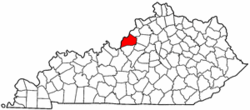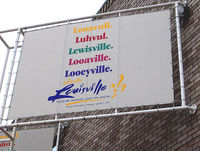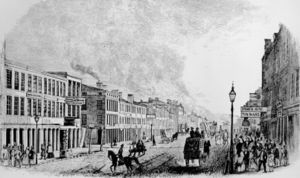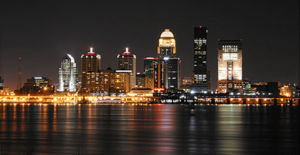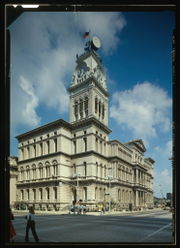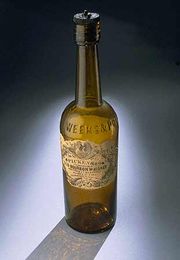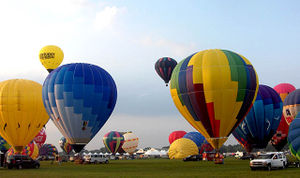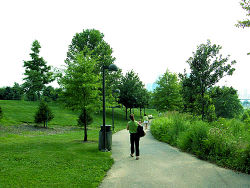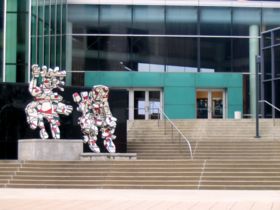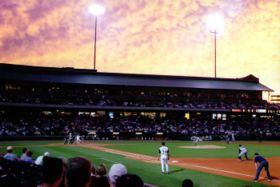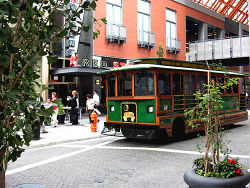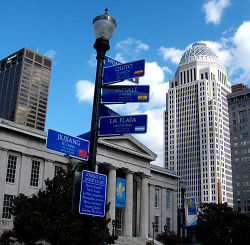Louisville, Kentucky
2007 Schools Wikipedia Selection. Related subjects: North American Geography
| Louisville, Kentucky | |||||
|
|||||
| Nickname: "Derby City", "River City", "Gateway to the South", "Falls City", "Da Ville" | |||||
| Location in the Commonwealth of Kentucky | |||||
| Coordinates: | |||||
|---|---|---|---|---|---|
| Country | United States | ||||
| State | Kentucky | ||||
| Counties | Jefferson | ||||
| Mayor | Jerry E. Abramson ( D) | ||||
| Area | |||||
| - City | 399 mi² / 1,032 km² | ||||
| - Land | 385 mi² / 997 km² | ||||
| - Water | 13 mi² / 35 km² | ||||
| Population | |||||
| - City (2005) | 699,827 | ||||
| - Density | 1,592.6/km² | ||||
| - Metro | 1.2 million | ||||
| Time zone | EST ( UTC-5) | ||||
| - Summer ( DST) | EDT ( UTC-4) | ||||
| Website: http://www.louisvilleky.gov/ | |||||
Louisville (usually pronounced ['luːǝvǝl] ; see Pronunciation below) is Kentucky's largest city. It is ranked as either the 16th or 27th largest city in the United States depending on how the population is calculated (see Nomenclature, population and ranking below). The settlement that became the City of Louisville was founded in 1778 by George Rogers Clark and is named after King Louis XVI of France. Louisville is most famous as the home of "The Most Exciting Two Minutes in Sports": the Kentucky Derby, the widely watched first race of the Triple Crown of Thoroughbred Racing.
Louisville is situated in north-central Kentucky on the Kentucky- Indiana border at the only natural obstacle in the Ohio River, the Falls of the Ohio. Louisville is the county seat of Jefferson County, and since 2003, the city's borders are contiguous with those of the county due to merger. Because it includes counties in Southern Indiana, the Louisville metropolitan area is regularly referred to as Kentuckiana. A resident of Louisville is sometimes referred to as a Louisvillian.
Influenced by both Midwestern and Southern culture, Louisville is often referred to as the northernmost Southern city and southernmost Northern city in the United States.
Nomenclature, population and ranking
As of the 2000 Census, Louisville had a population of 256,231. This was just under Lexington's merged consolidated city-county population of 260,512. However, on November 7, 2000, Louisville and Jefferson County approved a ballot measure to merge into a consolidated city-county government named Louisville-Jefferson County Metro Government (official long form) and Louisville Metro (official short form) which took effect January 1, 2003. A large portion of the population also uses Metro Louisville (unofficial form).
The U.S. Census Bureau gives two different population figures for Louisville: for the consolidated Louisville-Jefferson County it lists the 2005 estimated population as 699,827 (16th largest in the nation and equal to that of Jefferson County); for the Louisville-Jefferson County balance it lists the population as 556,429 (27th largest). The "balance" is a designation created by the Census Bureau to describe the portion of Louisville-Jefferson County that does not include any of the semi-independent separately incorporated places located within Louisville Metro (such as Anchorage, Middletown or Jeffersontown).
Census methodology uses balance values in comparing consolidated cities to other cities for ranking purposes, so the lower ranking (27th) is official as far as the Census is concerned. Nevertheless, the higher ranking (16th) continues to be claimed by Louisville Metro government and business leaders, widely reported in the local media, and has even been posted on road signs at the city limits.
The Louisville metropolitan area (not to be confused with Louisville Metro), having a population of approximately 1.2 million, ranks 43rd nationally. The metro area also includes some Southern Indiana counties (see Geography and climate below).
Pronunciation
Most long-time residents pronounce the city's name as ['luːǝvǝl] ( IPA) — often this degrades further into ['lǝvǝl] . The name is often pronounced far back in the mouth, in the top of the throat. The standard English pronunciation, however, is ['luːivɪl] (referring to King Louis XVI), which is often utilized by political leaders and the media. No matter how Louisville is pronounced, the 's' is always silent. (This contrasts with the name of the cities Louisville, Colorado and Louisville, Georgia, which, although spelled the same, are pronounced ['luːisvɪl] .)
The variability of the local pronunciation of the city's name can perhaps be laid at the feet of the city's location on the border between the North and South of the United States. Louisville's diverse population has traditionally represented elements of both Northern and Southern culture.
Regional migration patterns and the homogenization of dialect due to electronic media also may be responsible for the incidence of native-born Louisvillians adopting or affecting the standard English pronunciation. Nevertheless, the ['luːǝvǝl] pronunciation is most popular among residents and is, with little exception, used by news and sports reporters.
History
The history of Louisville spans hundreds of years, and has been influenced by the area's unique geography and location. The first settlement was made in the vicinity of modern-day Louisville in 1778 by Col. George Rogers Clark. Today, Col. Clark is now recognized as the founder of Louisville, and several landmarks are named after him.
Two years later, in 1780, the Virginia General Assembly and then- Governor Thomas Jefferson approved the town charter of Louisville. The city was named in honour of King Louis XVI of France, whose soldiers at the time were aiding Americans in the Revolutionary War. In 1803, explorers Meriwether Lewis and William Clark organized their expedition across America at the Falls of the Ohio in Louisville.
The city achieved its early growth from the fact that boats had to be unloaded and moved downriver before reaching the falls. By 1828, the population had swelled to 7,000 and Louisville became an incorporated city. The city grew rapidly in its formative years.
Louisville had one of the largest slave trades in the United States before the Civil War and much of the city's initial growth is attributed to that trade. Louisville was the turning point for many enslaved blacks since Kentucky was a neutral state and crossing the Ohio River would lead to freedom in the North.
During the Civil War Louisville was a major stronghold of Union forces, which kept Kentucky firmly in the Union. It was the centre of planning, supplies, recruiting and transportation for numerous campaigns. By the end of the war, Louisville itself had not been attacked even once, even though surrounded by various battles. The Unionists — most whose leaders owned slaves — felt betrayed by the abolitionist position of the Republican Party. After 1865 returning Confederate veterans largely took control of the city, leading to the jibe that it joined the Confederacy after the war was over.
In late January and February of 1937, a month of heavy rain throughout the Ohio River Valley prompted what became remembered as the "Great Flood of '37". The flood submerged about 70% of the city and forced the evacuation of 175,000 residents, and also lead to fundamental changes in where residents bought houses. Today, the city is protected by numerous flood walls.
Similar to many other older American cities, Louisville began to decline as an important city in the 1960s and 1970s. Highways that had been built in the 1950s facilitated a flight to the suburbs, and the downtown area began to decline economically. In 1974 a major ( F4) tornado hit Louisville as part of the Super Outbreak of tornadoes that struck 13 states. It covered 21 miles (34 km) and destroyed several hundred homes in the Louisville area but was only responsible for two deaths.
From 1974 to 1988, Jefferson County had a net loss of over 50,000 people. Since 1989 the county has gained population every year, and is currently growing annually between 800 to 1700. Louisville has also made efforts to revitalize its downtown and the city in general, including significant downtown infrastructure improvements such as the conversion of the waterfront into Waterfront Park and the development of luxury condominiums and entertainment areas like Fourth Street Live!. Louisville's metro area is outgrowing Lexington's by a significant margin (about 4,100 a year, or 41,000 per census), and is growing nearly as fast as Cincinnati's metro area.
Geography and climate
Geography
Louisville is located at (38.228870, -85.749534) GR1. According to the U.S. Census Bureau, Louisville Metro (in 2000 measurements for Jefferson County) has a total area of 1,032 km² (399 mi²). 997 km² (385 mi²) of it is land and 35 km² (13 mi²) of it (3.38%) is water.
Although officially in the Bluegrass region, most of Louisville is better described as being located in the low lying Ohio River flood plain. Prior to urbanization much of the area west of I-65 was composed of wetlands.
Areas generally east of I-65 were not in the flood plain and thus are mostly gentle rollings hills and were once farmland. Southern Jefferson County contains the scenic and largely undeveloped Knobs region, home to Jefferson Memorial Forest. The eastern portion of is in the Eden Shale Hills section of the Bluegrass region and has also experienced less urbanization than the flood plain, although that is starting to change.
The Louisville-Jefferson County, KY-IN Metropolitan Statistical Area (MSA), the 43rd largest in the United States, includes the Kentucky county of Jefferson (contiguous with Louisville Metro), plus twelve outlying counties — eight in Kentucky and four in Southern Indiana. This MSA is included in the Louisville-Elizabethtown-Scottsburg, KY-IN Combined Statistical Area (CSA), which also includes the Elizabethtown, KY MSA as well as the Scottsburg, IN Micropolitan Statistical Area. The Louisville CSA ranks 31st in the USA in population.
Climate
Louisville is located on the northern limit of the humid subtropical climate. Summers are hot and humid with mildly warm evenings. The mean annual temperature is 56 °F (13 °C), with an average annual snowfall of 16.4 inches (41 cm) and an average annual rainfall of 44.53 inches (1131 mm). The wettest seasons are the spring and summer, although rainfall is fairly constant all year round. During the winter, particularly in January and February, several days of snow can be expected, allowing for winter sports. Winter temperatures range from 27 to 43 °F (−3 to 6 °C) and summer temperatures range from 66 and 86 °F (19 and 30 °C). The highest recorded temperature was 105 °F (41 °C) on July 14, 1954, and the lowest recorded temperature was −22 °F (−30 °C) on January 19, 1994. However, in any season, temperatures can vary widely day by day, because of Louisville's location where many fronts often converge. Severe weather is not uncommon; the area is prone to almost all types of non-tropical weather extremes, including tornadoes, severe thunderstorms, ice storms and extreme heat and cold.
Much like the San Fernando Valley in Los Angeles, Louisville's Ohio River Valley location traps air pollution. Because of this, the city is ranked as one of Environmental Defense's fifty worst cities for air. Louisville also often exemplifies the heat island effect. Temperatures in commercial areas and in the industrialized areas along interstates are often higher than in the suburbs, particularly the shaded areas, like Anchorage, where temperatures are often five degrees cooler.
Cityscape
The downtown business district of Louisville is located immediately south of the Ohio River, and southeast of the Falls of the Ohio. Major roads extend outwards from the downtown area to all directions, like the spokes of a wheel. The airport is located approximately 6.5 miles (10 km) south of the downtown area. The industrial sections of town are located to the south and west of the airport, while most of the residential areas of the city are located to the southwest, south and east of downtown.
Another major business and industrial district is located in the suburban area east of the city on Hurstbourne Parkway. Louisville also boasts a large number of parks, with 122 parks covering more than 14,000 acres (57 km²). Recent initiatives have branded Louisville "A City of Parks".
The city's architecture contains a blend of old and new. The Old Louisville neighbourhood is the largest historic preservation district solely featuring Victorian homes and buildings in the United States, it is also the fourth largest such district overall. There are many modern skyscrapers downtown, as well as older preserved structures. The buildings of West Main Street in downtown Louisville boast the largest collection of cast iron facades of anywhere outside of New York's SoHo district.
Since the mid-20th century, Louisville has in some ways been divided up into three sides of town: the West End, the South End, and the East End. In 2003, Bill Dakan, a University of Louisville geography professor, said that the West End, west of 7th Street and north of Algonquin Parkway, is "a euphemism for the African-American part of town" although he points out that this belief is not entirely true, and most Africans Americans no longer live in areas where more than 80% of residents are black. Nevertheless, he says the perception is still strong. According to the Greater Louisville Association of Realtors, the lowest median home values are west of Interstate 65 in the West and South Ends, the middle range of home values are between Interstates 64 and 65 in the South and East Ends, and the highest median home values are north of Interstate 64 in the East End. Immigrants from Southeast Asia tend to settle in the South End, while immigrants from Eastern Europe settle in the East End.
In a Morgan Quitno survey in 2005, Louisville was rated as the seventh safest large city in the United States. The 2006 edition of the survey ranked Louisville eighth.
Government and politics
Louisville Metro is governed by an executive dubbed the Metro Mayor as well as a city legislature dubbed the Metro Council. The first and current Metro Mayor is Jerry E. Abramson ( D), who was also the longest serving Mayor of the former City of Louisville's history, serving from 1985 to 1998. This has earned him the nickname "Mayor for Life"
The Metro Council consists of 26 seats corresponding to 26 districts apportioned by population throughout the city. Half (13) of the seats come up for reelection every two years. The council is chaired by a Council President, who is elected by the council members annually.
The Official Seal of the City of Louisville, no longer used following the formation of a consolidated city-county government in 2003, reflected its history and heritage in the fleur-de-lis representing French aid given during the Revolutionary War, and the thirteen stars signify the original colonies. The new seal of the consolidated government retains the fleur-de-lis, but has only two stars, one representing the city and the other the county.
Kentucky's 3rd congressional district is roughly contiguous with Louisville Metro, which is represented by Rep. Anne Northup ( R), though some of the southern areas of the city are in the 2nd congressional district, which is represented by Ron Lewis (R). On November 7, 2006, John Yarmuth ( D) won the congressional election in the 3rd district and will replace Northup in January 2007. Democrats are the majority of registered voters in 424 of the 497 voting precincts in the 3rd congressional district.
Demographics
| City of Louisville Population by year (Pre-merger) |
|---|
|
2000 - 256,231 |
Note: All demographics are the same as that of Jefferson County, Kentucky, which merged with the former City of Louisville on January 6, 2003.
As of the census ² of 2000, there were 693,604 people, 287,012 households, and 183,113 families residing in the city/county. The population density was 695/km² (1,801/mi²). There were 305,835 housing units at an average density of 307/km² (794/mi²). The racial makeup of the city/county is 77.38% White, 18.88% Black or African American, 0.22% Native American, 1.39% Asian, 0.04% Pacific Islander, 0.68% from other races, and 1.42% from two or more races. 1.78% of the population were Hispanic or Latino of any race.
There were 287,012 households out of which 29.60% had children under the age of 18 living with them, 45.20% were married couples living together, 14.70% had a female householder with no husband present, and 36.20% were non-families. 30.50% of all households were made up of individuals and 10.30% had someone living alone who was 65 years of age or older. The average household size was 2.37 and the average family size was 2.97.
The age distribution is 24.30% under the age of 18, 8.90% from 18 to 24, 30.40% from 25 to 44, 22.80% from 45 to 64, and 13.50% who were 65 years of age or older. The median age was 37 years. For every 100 females there were 91.60 males. For every 100 females age 18 and over, there were 87.60 males.
The median income for a household is $39,457, and the median income for a family was $49,161. Males had a median income of $36,484 versus $26,255 for females. The per capita income for the county was $22,352. About 9.50% of families and 12.40% of the population were below the poverty line, including 18.10% of those under age 18 and 8.80% of those age 65 or over.
Many geographers consider Louisville to be Kentucky's primate city, since 17% of the state's population lives in Jefferson County and 25% live in counties in the Louisville CSA, and also Jefferson County has 2.5 times more people than Kentucky's second most populous county, Fayette County. Also, 12 of the 15 buildings in Kentucky over 300 feet are located in downtown Louisville. Over one-third of the population growth in Kentucky is in Louisville's CSA counties.
Religion
Religion is very prominent in Louisville which hosts several religious institutions of various faiths. There are 135,421 Catholic Louisvillians who attend 163 Catholic churches in the city. The Cathedral of the Assumption located in downtown Louisville is the seat of the Archdiocese of Louisville. Our Lady of Gethsemani Abbey, the monastic home of Catholic writer Thomas Merton, is in nearby Bardstown, Kentucky and also located in the archdiocese.
A sizable number of Louisvillians belong to a Protestant faith. Southeast Christian Church, one of the largest Christian churches in the United States, is located in Louisville. The city is home to Louisville Presbyterian Theological Seminary, Southern Baptist Theological Seminary and the headquarters of the Presbyterian Church (USA). Additionally, Louisville is home to the oldest African American Seventh-day Adventist congregation, Magazine Street Seventh-day Adventist temple.
There is also a noticeably large Jewish population of around 10,000 in the city. Most Jewish families came from Russia at the turn of the 20th century with a sizable number (around 1,000) of Soviet Jews having moved to Louisville since 1991. Jewish immigrants founded Jewish Hospital, which was once the centre of the city's Jewish district. Jewish hospital recently merged with the Catholic healthcare system CARITAS.
Economy
Louisville's early economy first developed through the shipping and cargo industries. Its strategic location at the Falls of the Ohio, as well as its unique position in the central United States (within one day's road travel to 60% of the cities in the continental U.S.) make it an ideal location for the transfer of cargo along its route to other destinations. The Louisville and Portland Canal and the Louisville and Nashville Railroad were important links in water and rail transportation. Louisville's importance to the shipping industry continues today with the presence of the Worldport air hub for UPS. Louisville's location at the crossroads of three major Interstate highways ( I-64, I-65 and I-71) also contributes to its modern-day strategic importance to the shipping and cargo industry.
Recently, Louisville has emerged as a major centre for the health care and medical sciences industries. Louisville has been central to advancements in heart and hand surgery as well as cancer treatment. Some of the first artificial heart transplants were conducted in Louisville. Louisville is also home to Humana, one of the nation's largest health insurance companies.
Louisville is home to several major corporations and organizations:
- Brown-Forman Corporation ( Fortune 1000)
- Hillerich & Bradsby (known for Louisville Slugger baseball bats)
- Hilliard Lyons (investment firm)
- Humana ( Fortune 500)
- Kindred Healthcare Incorporated ( Fortune 500)
- Norton Healthcare
- Papa John's Pizza
- Presbyterian Church (USA)
- Yum! Brands, Inc. (owners of KFC, Pizza Hut, and Taco Bell which were formerly Tricon Global Restaurants (a spin-off of PepsiCo) as well as Long John Silver's and A & W Restaurants which were formerly Yorkshire Global Restaurants) ( Fortune 500)
Louisville for a long time was also home to Brown & Williamson, the third largest company in the tobacco industry before merging with R. J. Reynolds in 2004 to form the Reynolds American Company. Brown & Williamson, one of the subjects of the tobacco industry scandals of the 1990s, was the focus of The Insider, a 1999 film shot around the Louisville area. Also located in Louisville are two major Ford plants, and a major General Electric appliance factory.
Additionally, one third of all of the bourbon whiskey comes from Louisville. The Brown-Forman Corporation is one of the major makers of bourbon, which is headquartered in Louisville. Other major distilleries of bourbon can be found both in the city of Louisville, or in neighboring cities in Kentucky.
Louisville also prides itself in its large assortment of small, independent businesses and restaurants, some of which have become known for their ingenuity and creativity. In 1926 the Brown Hotel became the home of the Hot Brown "sandwich". A few blocks away, the Seelbach Hotel, which F. Scott Fitzgerald references in The Great Gatsby, is also famous for a secret back room where Al Capone would regularly meet with associates during the Prohibition era.
Several major motion pictures have also been filmed in or near Louisville, including Goldfinger, Stripes, The Insider, Lawn Dogs, Nice Guys Sleep Alone, Keep Your Distance and Elizabethtown.
Culture
Annual festivals and other events
Louisville is home to a number of annual cultural events. Perhaps most well-known is the Kentucky Derby, held annually during the first Saturday of May. The Derby is preceded by a two-week long Kentucky Derby Festival, which starts with the annual Thunder Over Louisville, the largest annual fireworks display in the nation. The Kentucky Derby Festival also features notable events such as the Pegasus Parade, The Great Steamboat Race, Great Balloon Race, a marathon, and about seventy events in total.
Usually beginning in late February is the Humana Festival of New American Plays at Actors Theatre of Louisville, an internationally acclaimed new-play festival that lasts approximately six weeks.
The summer season in Louisville also features a series of cultural events such as the Kentucky Shakespeare Festival, held in July of every year and features free Shakespeare plays in Central Park in Old Louisville. The Kentucky State Fair is held every August at the Kentucky Exposition Centre in Louisville as well, featuring an array of culture from all areas of Kentucky.
In September is the Adam Matthews Balloon Festival, the fifth largest hot air balloon festival in the nation. The festival features early morning balloon races, as well as balloon glows in the evening. Also in September, in nearby Bardstown, is the annual Kentucky Bourbon Festival, which features some of the finest bourbon in the world. The suburb of Jeffersontown is also the home of the annual Gaslight Festival, a series of events spread over a week. Attendance is approximately 200,000 for the week.
The month of October features the St. James Court Art Show in Old Louisville. Thousands of artists gather on the streets and in the courtyard to exhibit and sell their wares, and the event is attended by many art collectors and enthusiasts.
Museums, galleries and interpretive centers

The West Main District in downtown Louisville features what is locally known as "Museum Row". In this area, the Frazier International History Museum, which opened in 2004, features a collection of arms, armor and related historical artifacts spanning 1,000 years, concentrating on U.S. and UK arms. The building features three stories of exhibits, two reenactment arenas, a 120-seat auditorium, and a 48-seat movie theatre. Also nearby is the Louisville Science Centre, which is Kentucky's largest hands-on science centre and features interactive exhibits, IMAX films, educational programs and technology networks.
The Muhammad Ali Centre opened November 2005 in "Museum Row" and features Muhammad Ali's boxing memorabilia, as well as information on the core themes that he has taken to heart: peace, social responsibility, respect and personal growth.
The Speed Art Museum opened in 1927 and is the oldest and largest art museum in the state of Kentucky. Located adjacent to the University of Louisville, the museum features over 1,200 pieces of art in its permanent collection. Multiple art galleries are located in the city, but they are especially concentrated in the East Market/ Butchertown area, next to downtown. This row of galleries, plus others in the West Main District, are prominently featured in the monthly "Gallery Hop", where gallery visitors board trolley buses for free rides back and forth between all the galleries.
There are also several historical properties and items of interest in the area, including the Belle of Louisville, the oldest Mississippi-style steamboat in operation in the United States. Fort Knox, spread out amongst Bullitt, Hardin and Meade Counties (two of which are in the Louisville metropolitan area), is home to the U.S. Bullion Depository and the Patton Museum of Cavalry and Armor. The Historic Locust Grove farm, former home of Louisville Founder George Rogers Clark, portrays life in the early days of the city. The Louisville area is also home to the Waverly Hills Sanatorium, a turn-of-the-century (20th) hospital that was originally built to accommodate tuberculosis patients, and is now listed as one of the nation's most haunted houses.
Across the river in Indiana, the interpretive centre at the Falls of the Ohio State Park (part of the Falls of the Ohio National Wildlife Conservation Area) functions as a museum with exhibits that concentrate on the natural history related to findings in the nearby exposed Devonian fossil bed as well as the human history of the Louisville area, covering pre-settlement, early settlement, and Louisville and southern Indiana history all the way up through the 20th century. Also of interest is the Howard Steamboat Museum and the John Hay Centre.
Parks and outdoor attractions
The Louisville area is home to 122 spacious city parks covering more than 14,000 acres (57 km²), located throughout the city. Several of these parks were designed by Frederick Law Olmsted, who also designed New York City's Central Park as well as parks, parkways, college campuses and public facilities in many U.S. locations. The Louisville Waterfront Park is prominently located on the banks of the Ohio River near downtown, and features large open areas, which often feature free concerts and other festivals. Cherokee Park is also one of the larger parks in the city, covering 409 acres (1.7 km²), and features many bicycle and nature trails, basketball courts, baseball fields and picnic pavilions.
Going a bit further out from the downtown area is the Jefferson Memorial Forest which, at 5,500 acres (22 km²), is the largest urban forest in the United States. The forest is designated as a National Audubon Society wildlife refuge, and offers over 30 miles (50 km) of various hiking trails. Camping and fishing are both permitted.
Otter Creek Park is another large park nearby. While actually in Brandenburg, Kentucky, Otter Creek Park is owned and operated by Louisville Metro government. The park's namesake, Otter Creek, winds along the eastern side of the park. A scenic bend in the Ohio River, which divides Kentucky from Indiana, can be seen from northern overlooks within the park. The park is a popular mountain biking destination, with trails maintained by a local mountain bike organization.
Other outdoor points of interest in the Louisville area include Cave Hill Cemetery and Arboretum (the burial location of Col. Harland Sanders), Zachary Taylor National Cemetery (the burial location of President Zachary Taylor), the Louisville Zoo, Six Flags Kentucky Kingdom and the Falls of the Ohio National Wildlife Conservation Area.
Performing arts
The performing arts community in Louisville is currently undergoing a bit of a renaissance. The Kentucky Centre, dedicated in 1983, located in the downtown hotel and entertainment district, features a variety of plays and concerts. This is also the home of the Louisville Ballet, Louisville Orchestra, and the Kentucky Opera, which is the twelfth oldest opera in the United States.
Actors Theatre of Louisville is another performing arts centre that has become the cornerstone of the revitalization of Louisville's Main Street. As the centerpiece of the city's urban cultural district, Actors Theatre has significant economic impact on a vital downtown life. Highly acclaimed for its artistic programming and business acumen, Actors Theatre hosts the Humana Festival of New American Plays each Spring. It also presents approximately six hundred performances of about thirty productions during its year-round season, composed of a diverse array of contemporary and classical fare.
The Louisville Palace, the official venue for the Louisville Orchestra, is an elegant, ornate theatre in downtown Louisville's so-called theatre district. In addition to orchestra performances, the theatre also features an array of popular movies, old and new, as well as concerts by popular artists.
Iroquois Park is the home of the renovated Iroquois Amphitheater which hosts the productions of Music Theatre Louisville as well as a variety of musical concerts in a partially covered outdoor setting.
Sports
College sports are very popular in greater Louisville, with an enormous following for the University of Louisville Cardinals. The U of L football and basketball teams are annual contenders among the top 25 teams in both sports. Rick Pitino coached the Cardinals to the Final Four in the NCAA basketball tournament in 2005 and Bobby Petrino guided the football team to the Gator Bowl in 2006.
Horse racing is also a major attraction. Churchill Downs is home to the Kentucky Derby, the largest sporting event in the state, as well as the Kentucky Oaks which together cap the two-week-long Kentucky Derby Festival. Churchill Downs has also hosted the renowned Breeders' Cup on five occasions, and will host that event again in 2006.
Louisville is also the home of Valhalla Golf Club which hosted the 1996 and 2000 PGA Championships and the 2004 Senior PGA Championship, and will host the 2008 Ryder Cup. It is also home to one of the top skateparks in the U.S., Louisville Extreme Park.
Louisville has four professional and semi-professional sports teams. The Louisville Bats are a baseball team playing in the International League as the Class AAA affiliate of the nearby Cincinnati Reds. The team plays at Louisville Slugger Field at the edge of the city's downtown. The Louisville Fire play in af2, the minor league of the Arena Football League.
The city of Louisville has made several unsuccessful bids in recent years to draw major league sports teams to the city, most notably when the Vancouver Grizzlies franchise was considering a move several years ago, as well as the Charlotte Hornets franchise, which ultimately ended up in New Orleans.
High school sports are also very popular in the city. Louisville area high schools have been dominant in football for decades. Schools such as Butler, St. Xavier, Trinity and Male have won every state 4A football title except one since 1992 and have been 13 of the 15 finalists since 1997. Some fierce rivalries have developed over the years. The annual game between St. Xavier and Trinity draws over 35,000 fans and is the second largest attended high school sporting event in the country. The 2002 KY State 4-A Football Championship between Male and Trinity is listed as one of the top 50 sporting events of all time by many critics. The "Old Rivalry" between Male and Manual high schools is one of the nation's oldest, dating back to 1893, and was played on Thanksgiving Day through 1980, with Manual winning the final T-Day game by a score of 6-0 in overtime.
Current professional teams
| Club | Sport | Founded | League | Venue |
|---|---|---|---|---|
| Louisville Bulls | Football | 1988 | Mid Continental Football League | Various |
| Louisville Kings | Australian rules football | 1996 | USAFL (USFOOTY) | Hays-Kennedy Park |
| Louisville Fire | Arena football | 2001 | af2 | Freedom Hall |
| Louisville Bats | Baseball | 2002 | International League | Louisville Slugger Field |
| Kentucky Colonels | Basketball | 2004 | American Basketball Association | Freedom Hall |
Infrastructure
Education
According to the U.S. Census, of Louisville's population over twenty-five, 21.3% (vs. a national average of 24%) hold a bachelor's degree or higher, and 76.1% (vs. 80% nationally) have a high school diploma or equivalent.
The public school system, Jefferson County Public Schools, consists of more than 98,000 students in Kindergarten through 12th Grade. The system consists of 87 elementary schools, 23 middle schools, 20 high schools and 23 other learning centers. Louisville has a large number of private schools, particularly unusual for a city of this size. Due to its large Catholic population, there are 27 Catholic schools in the city, as well as several Protestant schools, including the largest Protestant school system in the country in terms of student population. The Kentucky School for the Blind for all of Kentucky's blind and visually impaired students is located in Louisville as well.
Louisville is home to the University of Louisville, Bellarmine University, Spalding University, Sullivan University and Jefferson Community and Technical College (part of the Kentucky Community and Technical College System), as well as the Louisville Presbyterian Theological Seminary, Simmons College of Kentucky, and the Southern Baptist Theological Seminary. Indiana University Southeast is also located across the Ohio River in nearby New Albany, Indiana.
Transportation
Louisville's main airport is the centrally located Louisville International Airport, whose IATA Airport Code (SDF) reflects its former name of Standiford Field. The airport is also home to the UPS Worldport. Well over 3.5 million passengers and over 3 billion pounds (1,400,000 t) of cargo pass through the airport each year. Louisville International Airport is also the 4th busiest airport in the United States when it comes to cargo passage, and it is the 11th busiest when it comes to cargo passage in the world.
The much smaller Bowman Field is used mainly for general aviation. Some business aviation, as well as flight instruction and other private flying primarily operate out of this field.
The McAlpine Locks and Dam is located on the Kentucky side of the Ohio River, near the downtown area. The locks were constructed to allow shipping past the Falls of the Ohio. In 2001 over 55 million tons of commodities passed through the locks. A new lock is currently being constructed to replace two of the auxiliary locks, with a projected completion date of 2008.
Public transportation includes buses and chartered vans run by the Transit Authority of River City (TARC). The city buses serve all parts of downtown Louisville and Jefferson County, as well as Kentucky suburbs in Oldham County, Bullitt County, and the Indiana suburbs of Jeffersonville, Clarksville and New Albany. In addition to regular city buses, transit throughout the downtown hotel and shopping districts is served by a series of motorized trolleys (see right) known as the Toonerville II Trolley.
The city's road system is arranged in a fairly typical system common to many cities in the United States. Streets in the downtown business district are arranged as a grid, with several alternating one-way streets. Many major roads begin at or near the downtown area and travel outwards from the city like the spokes of a wheel. There are also several roads, such as Bardstown Road and Shelbyville Road, which lead outwards from Louisville to the outlying Kentucky towns of Bardstown and Shelbyville, respectively. (See External links for links to several online maps.)
Interstates I-64, I-65 and I-71 pass through Louisville. Since all three of these highways intersect at virtually the same location in the city, this spot has become known as " Spaghetti Junction", as the large mass of highways and exits resembles a bowl of spaghetti when viewed from the air. I-264 (Henry Watterson Expressway east of US 31W and Shawnee Expressway west of US 31W) and I-265 (Gene Snyder Freeway) form loops around the city on the Kentucky side. Plans for two more bridges to connect Louisville to Indiana are nearing completion. One bridge will be located downtown for relief of I-65 traffic. The other will connect the Indiana and Kentucky I-265's (via KY-841). Interestingly enough, Louisville is the only city in the nation to contain two consecutively-numbered, three-digit Interstate highways.
Louisville has historically been a major centre for railway traffic. The Louisville and Nashville Railroad was once headquartered here, before it was purchased by CSX Transportation. Today the city is served by two major freight railroads, CSX (with a major classification yard in the southern part of the metro area) and Norfolk Southern. Five major main lines connect Louisville to the rest of the region. Two regional railroads, the Paducah and Louisville Railway and the Louisville and Indiana Railroad, also serve the city. With the discontinuance of the short-lived Kentucky Cardinal in 2003, Amtrak passenger trains no longer serve Louisville; it is thus the third-largest city in the country (behind Phoenix and Columbus) with no passenger rail service.
Utilities
Electricity is provided to the Louisville Metro area by LG&E, a subsidiary of E.ON U.S. and traces its roots back to 1838 as Louisville Gas. Louisville Gas and Electric was formed in 1913 by the merger of Louisville Gas, Louisville Lighting (founded in 1903) and Kentucky Heating. In 1998, LG&E merged with Kentucky Utilities (KU) to form LG&E Energy. In 2000, LG&E Energy was bought by British utility company Powergen. In 2002, Powergen was bought by the German company E.ON. Finally, on December 1, 2005, LG&E Energy changed its name to E.ON U.S. Today, LG&E serves over 350,000 electric and over 300,000 natural gas customers, covers an area of 700 square miles (1800 km²), and has a total regulated electric generation capacity of 3,514 megawatts.
The current electric generating stations serving the city include three coal-fired plants (Trimble County, Mill Creek and Cane Run Stations), one natural gas/ fuel oil combustion turbine, one hydroelectric plant ( Ohio Falls Station), and two natural gas facilities (Muldraugh and Magnolia Compressor Stations).
Water is provided by the Louisville Water Company, which provides water to the more than 800,000 people in Greater Louisville as well as parts of Oldham and Bullitt counties. Additionally, they provide wholesale water to the outlying counties of Shelby, Spencer and Nelson.
The Ohio River provides for most of the city's source of drinking water. Water is drawn from the river at two points: the raw water pump station at Zorn and River Road, and the B.E. Payne Pump Station northeast of Harrods Creek. Water is also obtained from a riverbank infiltration well at the Payne Plant. There are also two water treatment plants serving the Louisville Metro area: The Crescent Hill Treatment Plant and the B.E. Payne Treatment Plant.
Sister cities
Louisville has seven sister cities:
 Jiujiang, China
Jiujiang, China La Plata, Argentina
La Plata, Argentina Mainz, Germany
Mainz, Germany Montpellier, France
Montpellier, France Perm, Russia
Perm, Russia Quito, Ecuador
Quito, Ecuador Tamale, Ghana
Tamale, Ghana
In addition, ![]() Leeds, United Kingdom is considered a "Friendship City." The two cities have engaged in many cultural exchange programs, particularly in the fields of nursing and law, and cooperated in several private business developments, including the Frazier International History Museum.
Leeds, United Kingdom is considered a "Friendship City." The two cities have engaged in many cultural exchange programs, particularly in the fields of nursing and law, and cooperated in several private business developments, including the Frazier International History Museum.



